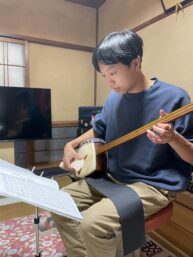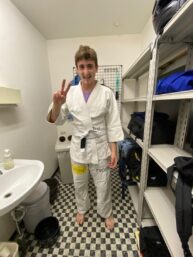
I decided to volunteer at an animal shelter for my CIP. I mainly took care of the dogs, and the members at the center would teach me how they walked, trained, bathed, and played with the dogs, as well as how they cleaned their enclosures.
I was able to interact with the other members quite a bit, as we would always take care of the dogs together, so if we were playing or walking them then I was able to engage in conversation with them. I also really enjoyed spending time with the dogs, and it was clear that the people at the center cared a lot about each of them.
I would advise future students to try starting a conversation with the people at your CIP. I was always nervous that maybe the other members wouldn’t want to talk to me because I’m a foreigner and my Japanese is far from perfect, but whenever I worked up the courage to ask them a question about themselves or the dogs we would always end up having a nice conversation, and it was a great opportunity for me to practice Japanese and connect more with the culture.









 For my CIP, I participated in the hip-hop/breakdancing club called Egoistic Dancers. At the club, we did some workshops and taught each other moves. They have different group chats for what year of breaking you are at, for example, if you are a first year, they would invite you to beginner workshops. The club didn’t really do any cyphering, which I feel like was very much needed, as it allowed everyone to interact with each other. Many of the club members were very busy with upcoming tournaments and shows, thus there was not much room to interact with fellow breakers. Unfortunately, they also did not have a real break space, so I would often go to another place to break. Some advice would be to do some more research before committing to a CIP, and it doesn’t always have to be something that you are really into, because if I could go back, I would have changed my CIP to something I’ve never done before but had some interest in. I think CIP should be moreso a place to meet and interact with the local Japanese students.
For my CIP, I participated in the hip-hop/breakdancing club called Egoistic Dancers. At the club, we did some workshops and taught each other moves. They have different group chats for what year of breaking you are at, for example, if you are a first year, they would invite you to beginner workshops. The club didn’t really do any cyphering, which I feel like was very much needed, as it allowed everyone to interact with each other. Many of the club members were very busy with upcoming tournaments and shows, thus there was not much room to interact with fellow breakers. Unfortunately, they also did not have a real break space, so I would often go to another place to break. Some advice would be to do some more research before committing to a CIP, and it doesn’t always have to be something that you are really into, because if I could go back, I would have changed my CIP to something I’ve never done before but had some interest in. I think CIP should be moreso a place to meet and interact with the local Japanese students.